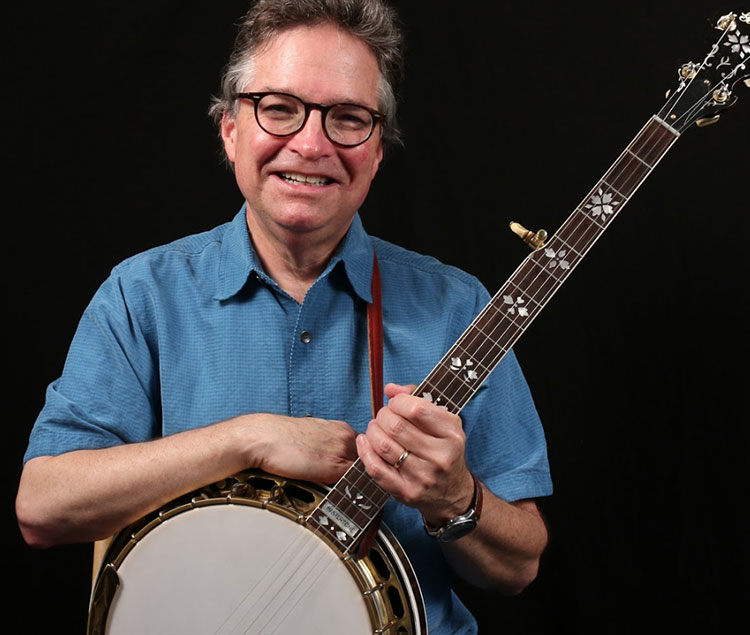After his interview with Thomas Goldsmith, Bill turns to Earl’s banjo-and-fiddle duet accompaniment style, analyzing “Grey Eagle” from a 1950s radio broadcast with fiddler Benny Martin and “Fiddle and Banjo (Stoney Point)” with fiddler Paul Warren, from Flatt and Scruggs’s December 1962 Carnegie Hall concert. Bill also takes a look at “Across the Blue Ridge Mountains” (also known as “My Home’s Across the Blue Ridge Mountains”) from Flatt and Scruggs’s 1963 Vanderbilt University concert in Nashville, discussing Earl’s solo and analyzing the different backup approaches Earl uses throughout the song.

Earl Scruggs is without question the most influential five-string banjo player in the history of the instrument and a thorough understanding of his style is essential to playing bluegrass banjo well. Earl Scruggs: A Player’s Guide picks up where Earl’s renowned instruction book Earl Scruggs and the Five-String Banjo leaves off, teaching tunes and techniques to enable each student to become a more complete Scruggs-style player.
Among the topics covered are:
Easy Earl: straightforward tunes and solos (“Shortening Bread”)
Early Earl: Earl with Bill Monroe and His Blue Grass Boys
Fiddle tune and slow song (teardrop) back-up (“Fiddle and Banjo,” “I’ll Just Pretend”)
Solos to Flatt and Scruggs vocal tunes (“Head over Heels,” “Doin’ My Time”)
Up-the-neck solos & discussion of fingering (“Why Did You Wander?”)
Boogie-Woogie Earl, licks and solos (“Six White Horses”)
Drop-C tuning (“Farewell Blues,” “Ain’t Gonna Work Tomorrow”)
Earl’s most awesome licks for leads and back-up
Bill also invited 1996 IBMA Banjo Player of the Year Charlie Cushman to join him as a very special guest for one workshop session. Charlie plays banjo and Earl Scruggs–style guitar in the Earls of Leicester, the Flatt and Scruggs tribute band led by dobro legend Jerry Douglas. He discusses some of the most important aspects of Earl’s playing that move beyond tablature, including Earl’s fingering choices, right-hand rhythm and note spacing, and much more.
For those of you taking Bill’s courses on Peghead Nation, note that there is no repetition of Scruggs content with the lessons on the Beginning Banjo and Bluegrass Banjo courses.
Bill talks about what he’ll be covering in his workshop and gives recommended reading and listening ideas.
Bill starts Earl Scruggs: A Player’s Guide by talking about Earl Scruggs’s early years and then he looks at his playing with Bill Monroe from 1946 to 1947, with tab for “Cripple Creek,” “Molly and Tenbrooks,” “Ain’t Nobody Gonna Miss Me,” and “Blue Grass Breakdown.”
Bill talks about Flatt and Scruggs’s groundbreaking Mercury Sessions, in particular Earl’s playing on the songs “Down the Road,” “No Mother or Dad,” “Why Don’t You Tell Me So,” and the iconic banjo instrumental “Foggy Mountain Breakdown.”
Bill continues his discussion of Flatt and Scruggs’s groundbreaking Mercury Sessions, focusing in this session on the songs “Farewell Blues,” “Doin’ My Time,” and “I’ll Never Love Another.” He also reviews “Foggy Mountain Breakdown” from the last session.
In this session, Bill looks at Earl’s leads and back-up to “Doin’ My Time” from the Mercury Sessions along with three great solos (“I’m Head Over Heels In Love,” “I’ll Stay Around,” and “The Old Home Town”) from Flatt and Scruggs’ November 21, 1950, Columbia Records session. These are all classic performances and he uses these breaks to analyze Earl’s approach to creating solos to Lester’s vocal tunes.
In this session, Bill is joined by 1996 IBMA Banjo Player of the Year Charlie Cushman. Charlie plays banjo and Earl Scruggs–style guitar in the Earls of Leicester, the Flatt and Scruggs tribute band led by dobro legend Jerry Douglas. He discusses some of the most important aspects of Earl’s playing that move beyond tablature, including Earl’s fingering choices, right-hand rhythm and note spacing, and much more.
In this session, Bill looks at Earl’s “boogie-woogie” style, exploring the jazzy licks and techniques used in the classic tunes “Foggy Mt. Special,” “Six White Horses,” and more. Bill will explore some of the most challenging aspects of these songs, discussing right- and left-hand fingerings, rhythmic approach, back-up, and more, expanding upon many of the ideas introduced in Sessions 2 and 3 on the songs “Down The Road” and “Doing My Time.”
In this session, Bill is joined live by Thomas Goldsmith, the author of Earl Scruggs and Foggy Mountain Breakdown: The Making of an American Icon. He explores with Thomas his research for the book, his relationship with Earl and the Scruggs family, Earl’s early life and influences, and much more. After the talk, Bill looks at Earl’s banjo-and-fiddle duet accompaniment style as well as his solo and backup on “Across the Blue Ridge Mountains” from Flatt and Scruggs’s 1963 Vanderbilt University concert.
Bill begins this final session with a review of the fiddle tune backup techniques presented in Session 7 and an analysis of Earl’s straightforward solo to “Across The Blue Ridge Mountains.” To finish things up, Bill presents what he calls “Earl’s Gems: Rolling and Vamping,” comparing and contrasting licks in D and C as well as presenting some of the most advanced vamping-based licks heard in “Flint Hill Special.” and “Bugle Call Rag.”